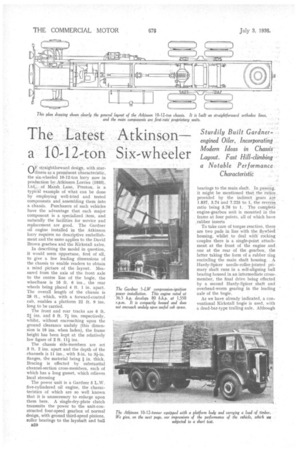The i Latest Atkinson
Page 30

Page 31

If you've noticed an error in this article please click here to report it so we can fix it.
a 10-12-ton Six-wheeler
Sturdily Built Gardnerengined Oiler, Incorporating Modern Ideas in Chassis Layout. Fast Hill-climbing a Notable Performance Characteristic
OFstraightforward design, with sturdiness as a prominent characteristic, the six-wheeled 10-12-ton lorry now in production by .Atkinson .Lorries (1933), Ltd., of Marsh Lane, Preston, is a typical example of vvhat can be done by employing well-tried and tested components and assembling them into a chassis. Purchasers of such vehicles have the advantage that each major component is a specialized item, and naturally the facilities for service and replacement are good. The Gardner oil engine installed in the Atkinson lorry requires no descriptive embellishment and the same applies to the David Brown gearbox and the Kirkstall axles.
In describing the model in question, it would seem opportune, first of all, to give a few leading dimensions of the chassis to enable readers to obtain a mind picture of the layout. Measured from the axis of the front axle to the centre line of the bogie, the wheelbase is 16 ft. 6 ins., the rear wheels being placed 4 ft. 1 in, apart. The overall length of the chassis is 28 ft., which, with a forward-control cab, enables a platform 22 ft. 9 ins. long to be carried.
The front and rear tracks are 6 ft. 21 ins, and 5 ft. 71 ins, respectively, whilst, without encroaching upon the ground clearance unduly (this dimension is 10 ins, when laden), the frame height has been kept at the relatively low figure of 2 ft. 11i ins.
The chassis side-members are set 3 ft. 2 ins, apart and the depth of the channels is 11 ins., with 3-in. to 3i-in. flanges, tile material being j in. thick, Bracing is effected by substantial channel-section cross-members, each of which has a long gusset, which relieves local stressing The power unit is a Gardner 5 L.W. five-cylindered oil engine, the characteristics of which are so well known that it is unnecessary to enlarge upon them here. A single-dry-plate clutch transmits the power to the unit-constructed four-speed gearbox of normal design, with ground third-speed pinions, roller bearings to the layshaft and ball ri20
bearings to the main shaft. In passing. it might be mentioned that the ratios provided by the indirect gears are 1.837, 3.74 and 7.225 to 1, the reverse ratio being 5.76 to I. The complete engine-gearbox unit is mounted in the frame at four points, all of which have :rubber inserts
To take care of torque reaction, there are two pads in line with the flywheel housing, whilst to deal with rocking couples there is a single-point attachment at the front of the engine and one at the rear of the gearbox, the latter taking the form of a rubber ring encircling the main shaft housing. A Hardy-Spicer needle-roller-jointed primary shaft runs in a self-aligning ball bearing housed in an intermediate crossmember, the final drive being effected by a second Hardy-Spicer shaft and overhead-worm gearing in the leading ' axle of the bogie.
As we have already indicated, a con., ventional Kirkstall bogie is used, with a dead-bar-type trailing axle. Although the wheels on the third axle are not driven, they are used for braking purposes. A pair of 17-in.-diameter drums (of similar dimensions to those of the other axles) are equipped with internalexpanding shoes, the friction facings of which are 6 ins, wide, whilst the front shoes are, of course, narrower, the width being 3 ins.
All brakes are applied by the pedal, through the medium of a Dewandre servo cylinder, with Lockheed hydraulic cylinders to transmit the pull.
A neat job has been made of the mounting for the cast-aluminium radiator on the front-panel of the cab, the plated grille affording adequate protection for a single stack of gilled tubes which form the cooling surface. Other points Worth recording are that the steering is of the worm-and-sector type' with the low ratio of -25 to 1, to afford easy control when rnanceuvring, whilst the road wheels are of the usual steel-disc type secured to cast-steel hubs by fin.-diameter nickel-steel studs. The standard tyre equipment is 36 by 8 singles at the front and twins of the same dimensions at the rear; a fuel tank of 35-gallon capacity is standardized: During our visit to the Atkinson works we had an opportunity of trying a fully laden 12-tonner on the road, and, although we were unable to complete one of our comprehensive road trials, wo nevertheless obtained a working impression of the behaviour of all the n1ajor components. The gear ratios seem to be suited to the load and power of the engine, there being a good reserve when traversing reasonably flat main roads at the maximum legal sPeed. The performance On' a hill in the Preston district is worthy of mention. An easy climb was made in second gear with 11 tons of timber on board, but we noticed that, at the time of our ascent, a number of similarly heavily laden vehicles was forced to use bottom gear, and their speeds were, in consequence,
considerably lower than were OUTS. When manceuvring, reversing or parking the vehicle, the low-ratio steering gives a light action to the wheel, yet the movements do not appear excessive when traversing a winding road.
Speeds up to 30 m.p.h. in top gear are well within the capacity of the power unit, whilst it is possible to climb at approximately 15 m.p.h. in " third " and 18 m.p.h, in "second." We sum up this Atkinson as a good all-round vehicle, built of high-grad. components, which should give long service without trouble




















































































